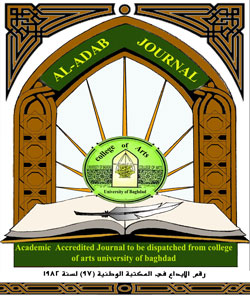A Stylistic Analysis of Nature in Two Selected, English and Arabic, Pastoral Poems
DOI:
https://doi.org/10.31973/295jnm76Keywords:
Stylistics , Pastoral Poetry, Lexical Items, Figures of SpeechAbstract
Since stylistics is concerned with studying styles, the present paper is an analysis of the styles in selected poems. Style is grasped by analyzing the choice and use of stylistic devices; therefore, this study investigates the lexical items and the figures of speech in two English and Arabic pastoral poems, namely Matthew Arnold’s The Scholar Gipsy and Kahlil Gibran’s Al-Mawakib. These poems share the same theme which is nature. Both idealize nature by praising it as being a source of imagination and inspiration. Yet, the poems also describe a city in a different description. Therefore, contrast is the style adopted in pastoral poetry and it is achieved by manipulating some stylistic devices. The study adopts Leech and Short's (2007) checklist of stylistic markers as a framework for analysis. The findings of the analysis show great similarities in using the same stylistic devices in a contrastive manner in both poems with differences only in the frequency rates.
Downloads
References
Abrams, M. H. & Harpham, G. G. (2005). A Glossary of Literary Terms. Boston: Thomson Wadsworth.
Baldick, C. (2001). The Concise Oxford Dictionary of Literary Terms. Oxford: Oxford University Press.
Carnie, A. (2013). Syntax: A generative introduction. Malden, MA: Blackwell Publishers.
Cuddon, J. A. (2012). A Dictionary of Literary Terms and Literary Theory. Oxford: Wiley-Blackwell.
Enkvist, N.E. (1973) Linguistics stylistics. The Hague: Mouton.
Ghazwan, ‘inad. (2000). Asda’ Dirasat Adbbia Naqdia. Damascus: Itihad Manshurat AL-Kittab Al-Arab.
Keenan, R. (1965). The Poetry of Matthew Arnold. New York: Monarch Press.
Leech, G. & Short, M. (2007). Style in Fiction: A Linguistic Introduction to English Fictional Prose. (2nd ed.). London: Pearson.
Leech, G. and Short, M. (1981). Style in Fiction. New York: Longman Group Limited.
Lehman, P.W. (1996). Descriptive Linguistics: An Introduction. New York: Random House Inc.
Mahalakshmi, S. (2014). A Study on the Element of Conflict in Arnold’s The Scholar Gipsy and T. S. Eliot’s The Hollow Men. Bharathiyar University. Research Nebula.
McArthur, T. (1992). Figurative Language. In: The Oxford Companion to the English Language (ed. T. McArthur) Oxford University Press.
Mustafa, Amāl Ibrahim. (2018). Jamaliat al-Tathad fi Qasidat al-Mawakib li Gibran Khalil Gibran. Jam‘iat Por Said, Mujalat Kuliat Al-Adab.
Najimi, Wahiba and Bumakwaz, ṣaraa and Tunisi, Jamila. (2021). Muqaraba Islubia li qasidat Al-Mawakib li Gibran Khalil Gibran. Jam‘iat Al-Bawera.
Najjar, Iskander. (2008). Qamus Gibran Khalil Gibran. Beirut: Dar Al-Saqi.
Nebeker, H. (1971). A Study in Paradox: Matthew Arnold’s “The Scholar Gipsy”. The Bulletin of the Rocky Mountain Modern Language Association. (https://doi.org10.2307/1346628) accessed: 17/6/2022
Shaw, H. (1972). Dictionary of Literary Terms. McGrow-Hill.
Short, M. (1996). Exploring the Language of Poems, Plays and Prose. London: Addison. Wesley Longman Limited
Simpson, P. (2004). Stylistics: A Resource Book for Students. London: Routledge.
Vandana V. (2019). Mathew Arnold’s The Scholar Gipsy: A Pastoral Elegy. International Research Journal of Commerce Arts and Science ( https://www.casirj.com ) accessed: 17/6/2022
Verdonk, p. (2002). Stylistics. Oxford: Oxford University Press.
Widdowson, H. G. (1975). Stylistics and teaching of literature. London: Longman.
Downloads
Published
Issue
Section
License
Copyright (c) 2024 Abbas Mohammed Hussein، Abdali Al-Saidi

This work is licensed under a Creative Commons Attribution 4.0 International License.
Copyright and Licensing:
For all articles published in Al-Adab journal, copyright is retained by the authors. Articles are licensed under an open access Creative Commons CC BY 4.0 license, meaning that anyone may download and read the paper for free. In addition, the article may be reused and quoted provided that the original published version is cited. These conditions allow for maximum use and exposure of the work.
Reproducing Published Material from other Publishers: It is absolutely essential that authors obtain permission to reproduce any published material (figures, schemes, tables or any extract of a text) which does not fall into the public domain, or for which they do not hold the copyright. Permission should be requested by the authors from the copyrightholder (usually the Publisher, please refer to the imprint of the individual publications to identify the copyrightholder).
Permission is required for: Your own works published by other Publishers and for which you did not retain copyright.
Substantial extracts from anyones' works or a series of works.
Use of Tables, Graphs, Charts, Schemes and Artworks if they are unaltered or slightly modified.
Photographs for which you do not hold copyright.
Permission is not required for: Reconstruction of your own table with data already published elsewhere. Please notice that in this case you must cite the source of the data in the form of either "Data from..." or "Adapted from...".
Reasonably short quotes are considered fair use and therefore do not require permission.
Graphs, Charts, Schemes and Artworks that are completely redrawn by the authors and significantly changed beyond recognition do not require permission.
Obtaining Permission
In order to avoid unnecessary delays in the publication process, you should start obtaining permissions as early as possible. If in any doubt about the copyright, apply for permission. Al-Adab Journal cannot publish material from other publications without permission.
The copyright holder may give you instructions on the form of acknowledgement to be followed; otherwise follow the style: "Reproduced with permission from [author], [book/journal title]; published by [publisher], [year].' at the end of the caption of the Table, Figure or Scheme.











